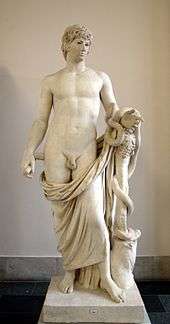Agathodaemon
An agathodaemon (Ancient Greek: ἀγαθοδαίμων, agathodaímōn) or agathos daemon (ἀγαθός δαίμων, agathós daímōn, lit. 'noble spirit') was a spirit (daemon) of the vineyards and grainfields in ancient Greek religion. They were personal companion spirits,[2][3] comparable to the Roman genii, who ensured good luck, health, and wisdom.
During the classical period
Though little noted in Greek mythology (Pausanias conjectured that the name was merely an epithet of Zeus),[4] he was prominent in Greek folk religion;[5] it was customary to drink or pour out a few drops of unmixed wine to honor him in every symposium or formal banquet. In Aristophanes' Peace, when War has trapped Peace (Εἰρήνη Eirene) in a deep pit, Hermes comes to give aid: "Now, oh Greeks! is the moment when, freed of quarrels and fighting, we should rescue sweet Eirene and draw her out of this pit... This is the moment to drain a cup in honor of the Agathos Daimon." A temple dedicated to them was situated on the road from Megalopolis to Maenalus in Arcadia.[6]
An Agathos Daimon was the spouse or companion of Tyche Agathe (Τύχη Ἀγαθή, "Good Fortune"; Latin: Agatha). "Tyche we know at Lebadeia as the wife of the Agathos Daimon, the Good or Rich Spirit".[7][8] Their numinous presence could be represented in art as a serpent or more concretely as a young man bearing a cornucopia and a bowl in one hand, and a poppy and an ear of grain in the other.[7] The agathodaemon was later adapted into a general daemon of fortuna, particularly of the continued abundance of a family's good food and drink.
During late antiquity
In the syncretic atmosphere of Late Antiquity, agathodaemons could be bound up with Egyptian bringers of security and good fortune: a gem carved with magic emblems bears the images of Serapis with crocodile, sun-lion and Osiris mummy surrounded by the lion-headed snake Chnum–Agathodaemon–Aion, with Harpocrates on the reverse.[9]
See also
References
- The torso of an Apollo was found in the Tiber at Rome and was restored as an Antinous with a head found separately; it was purchased through Giovanni Ludovico Bianconi, about 1760; formerly exhibited in the Neues Palais, Potsdam (Arachne Projekt); noted in Karl Otfried Müller, Nouveau manuel complet d'archéologie ou traité sur les antiquités grecques... (1841:vol. I:298) and in Bouillon II:51.
- Hor. Ep. ll, 2, 187.
- Tibull. IV, 8
- Pausanias, Description of Greece, viii. 36. § 3
- Martin P. Nilsson, Greek Folk Religion. (Columbia University Press), 1981:33, 70, 73.
- Schmitz, Leonhard (1867), "Agathodaemon", in Smith, William (ed.), Dictionary of Greek and Roman Biography and Mythology, 1, Boston, p. 65
- Chisholm 1911, p. 371.
- Harrison 1922, pp. 355–ff, 543.
- Illustrated in W. Fauth, Helios Megistos: zur synkretistischen Theologie der Spätantike (Leiden: Brill) 1995:85.

Bibliography
- Harrison, Jane Ellen (1922). Prolegomena to the Study of Greek Religion (3rd ed.). pp. 355–ff, 543.CS1 maint: ref=harv (link)
External links
| Wikimedia Commons has media related to Agathodaimon. |
- Theoi.com: Greek and Latin sources in translation
